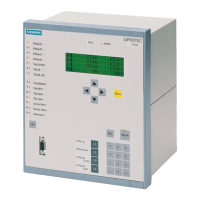'(& )( )'& &) ( &!& ")& &$(( $# Ć %&( $# #)" &&#$
6 - 37
Siemens AG ⋅ May 1998
6.4.2 Marshalling of binary inputs, binary outĆ
puts and LED indications
6.4.2.1 Introduction
It is the purpose of the marshalling to allocate logical
functions to the hardware binary inputs, command
and alarm relays and LEDs.
The ex works pre-set alarms can be seen in the geĆ
neral diagrams (annex A.1.2).
The allocation of the inputs and outputs in conforĆ
mance with the requirements of the specific applicaĆ
tion is carried out via the integrated keypad and starts
with
DA 6000/FE.
Marshalling starts with selection of the desired binary
input, relay or LED. By depressing the "ENTER"-key,
the third level of the operating tree is reached. Input
of password is requested.
In the third level a marshalling point (out of 20 availaĆ
ble) can be selected by operating the horizintal arrow-
keys A". This means, for each binary input, relay or
LED, 20 logical functions can be marshalled. After
selecting the marshalling point, the change mode is
entered by depressing the key "ENTER" twice. In the
change mode, the desired event is marshalled to this
marshalling point by means of the horizontal arrow
keys A". The selected functional marshalling is
terminated with the key "ENTER".
When marshalling functions to binary inputs, an addiĆ
tional selection is carried out during scrolling, whether
the input functions in a "working-current" or "quieĆ
scent-current" mode. When marshalling the LEDs,
the options "memorized" or "not memorized" can
additionally be selected.
The third level is left with the key "ESC" or one of
the vertical arrow keys.
Repeated operation of the "ESC"-key means leaving
the password area. In case of changes in the setĆ
tings, the question is asked whether the new settings
shall be stored.
Y
B
6 0 0 0 J M A R S H A L L I N G
Start of the marshalling blocks
6.4.2.2 Marshalling of the binary inputs -
block 61
The bay unit has 20 binary inputs, designated with
"BINARY INPUT 1" to "BINARY INPUT 20".
Marshalling of the binary inputs is carried out in adĆ
dress block 6100. For each binary input function, worĆ
king-current or quiescent-current can be selected.
A - working-current:
An input is activated by a NO contact, i.e. control volĆ
tage at the input terminals activates the marshalled
function;
R - quiescent current:
An input is activated by a NC contact, i.e. control volĆ
tage at the input terminals cancels the function, wiĆ
thout control voltage it is active.
Table 6.6 gives an overview of the marshallable input
functions with corresponding function numbers (FNo).

